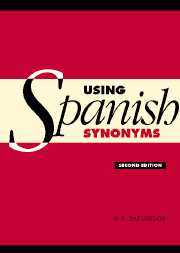Book contents
- Frontmatter
- Contents
- Acknowledgements for the second edition
- List of abbreviations
- Introduction
- Introduction to second edition
- Spanish synonyms
- Index of Spanish items with frame titles
- Index of Argentinian items with frame titles
- Index of Mexican items with frame titles
- Index of English items with frame titles
Introduction to second edition
Published online by Cambridge University Press: 05 June 2012
- Frontmatter
- Contents
- Acknowledgements for the second edition
- List of abbreviations
- Introduction
- Introduction to second edition
- Spanish synonyms
- Index of Spanish items with frame titles
- Index of Argentinian items with frame titles
- Index of Mexican items with frame titles
- Index of English items with frame titles
Summary
Twelve years have now elapsed since the appearance of the first edition of the present volume, which has met with universal approval and very positive reviews. It now seems an appropriate time to offer a second edition, and this for numerous reasons.
First, much has changed in the world over this ten-year period, technologically, socially, politically, and geographically, all due to the process of globalization. Second, the ever-expanding role of American Spanish-speaking countries, notably Mexico, requires our attention much more than, say, twenty years ago. Iberian Spanish is no longer the dominant variety of Spanish that it once was, so that the criterion for “standard” Spanish is now arguably in Mexico and not in Spain. At the same time, the core language of Spain still prevails so that, for example, the key words or frame titles are in current use in both Spain and Mexico, with the exception of volver.
Third, as in Iberian Spanish, the range of vocabulary in Argentinian and Mexican Spanish grows at an ever-increasing pace. This is particularly true of Mexican suffixes such as -ada (andada, bailada, platicada, viejada and zurcida), -ito (dinerito, vestidito, fiestecita, agüita, solito (sun and alone), and -azo (avionazo, trenazo, cabronazo, carambazo, chingadazo, cocotazo, colazo). Such suffixes do exist in Iberian Spanish (llamada, llegada, casita, chiquito, cochazo, mazazo) but are nowhere near as common as in Mexico, especially the diminutives.
- Type
- Chapter
- Information
- Using Spanish Synonyms , pp. 7 - 8Publisher: Cambridge University PressPrint publication year: 2006



